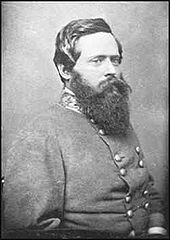Fitzhugh Lee
Fitzhugh Lee | |
|---|---|
John E. Massey | |
| Preceded by | William E. Cameron |
| Succeeded by | Philip W. McKinney |
| Personal details | |
| Born | November 19, 1835 |
| Battles/wars | American Civil War Spanish–American War |
Fitzhugh Lee (November 19, 1835 – April 28, 1905) was a Confederate cavalry general in the American Civil War, the 40th Governor of Virginia, diplomat, and United States Army general in the Spanish–American War. He was the son of Sydney Smith Lee, a captain in the Confederate States Navy, and the nephew of Robert E. Lee.
Early life
Fitzhugh Lee was born at
Graduating from the
American Civil War
This section needs additional citations for verification. (August 2022) |
Fitzhugh Lee joined the
Fitzhugh Lee performed well in the

After Chancellorsville, Lee was incapacitated by inflammatory rheumatism, missing a month of action, which included the significant cavalry operations at the
In the
At the
Fitzhugh Lee subsequently joined Early for his campaign against Maj. Gen.
Later life

After the war, Fitzhugh Lee devoted himself to farming in Stafford County, Virginia, and was conspicuous in his efforts to reconcile the Southern people to the issue of the war, which he regarded as a final settlement of the questions at issue.[citation needed] In 1875, he attended the Battle of Bunker Hill centennial at Boston and delivered an address. In 1885, he was a member of the board of visitors of West Point, and from 1886 to 1890 was governor of Virginia having defeated in 1885 Republican John Sergeant Wise with 52.77% of the vote.[5]
Fitzhugh Lee commanded the third division at President Grover Cleveland's inaugural parades in 1885 and 1893.[9] In April 1896, Lee was appointed consul-general at Havana by President Cleveland, with duties of a diplomatic and military character added to the usual consular business. In this post (in which he was retained by President William McKinley until 1898), he was the first called upon to deal with a situation of great difficulty, which culminated with the destruction of the warship USS Maine. Upon the declaration of war between Spain and the United States, he re-entered the army.
He was one of four ex-Confederate general officers who were made major generals of United States Volunteers (the others being Matthew Butler, Joseph Wheeler, and Thomas L. Rosser). Fitzhugh Lee commanded the 7th Army Corps but took no part in the actual operations in Cuba. He was military governor of Havana and Pinar del Río in 1899, subsequently commanded the Department of the Missouri, and retired in 1901 as a brigadier general, U.S. Army.[5]

Lee was an early leader of the committee for the Jamestown Exposition, which would be held after his death at Sewell's Point on Hampton Roads in 1907. Lee died in Washington, D.C., and is buried in Hollywood Cemetery, Richmond, Virginia.
Fitzhugh Lee wrote the article about Robert E. Lee in the Great Commanders series (1894), General Lee, a wartime biography (1894), and Cuba's Struggle Against Spain (1899).
Legacy
He was indicted for treason but the indictment was withdrawn in February 1869. Lee then received a pardon.[10] The Seventh Army Corps Association and Auxiliary dedicated a monument to Lee's service to the 7th Army Corps from 1898 to 1899, placing it in Monroe Park, Richmond, Virginia; the City of Richmond removed the monument on July 9, 2020, by the city, in recognition of Lee's participation in the Confederacy.[11]
See also
References
- ^ Chisholm 1911, p. 360.
- ^ ISBN 978-0-8047-3641-1.
- OCLC 166632575.
- ^ a b "Fitzhugh Lee (1835–1905)". Encyclopedia Virginia. March 9, 2010. Retrieved January 22, 2012.
- ^ a b c d e Chisholm 1911, p. 361.
- ISBN 1-882810-30-9.
- ^ Fort Pocahontas (2) at FortWiki.com
- ISBN 0-02-926880-X.
- ^ "Gen. Lee to Command: He Will Head a Division in the Inaugural Parade". The New York Times. February 19, 1893. Retrieved: July 8, 2008
- ^ Longacre, Edward (December 22, 2021). "Fitzhugh Lee (1835–1905)". Encyclopedia Virginia. Virginia Humanities. Retrieved February 26, 2023.
- ^ "VCU committee recommends removal of Confederacy-affiliated chapel, building names, memorabilia". The Commonwealth Times. July 16, 2020. Retrieved February 26, 2023.
- Attribution
- This article incorporates text from a publication now in the public domain: Chisholm, Hugh, ed. (1911). "Lee, Fitzhugh". Encyclopædia Britannica. Vol. 16 (11th ed.). Cambridge University Press. pp. 360–361.
Further reading
- Longacre, Edward G. Lee's Cavalrymen: A History of the Mounted Forces of the Army of Northern Virginia. Mechanicsburg, Pennsylvania: Stackpole Books, 2002. ISBN 0-8117-0898-5.
- Sifakis, Stewart. Who Was Who in the Civil War. New York: Facts On File, 1988. ISBN 978-0-8160-1055-4.
- ISBN 978-0-8071-0823-9.
External links
- Fitzhugh Lee in Encyclopedia Virginia
- A Guide to the Executive Papers of Governor Fitzhugh Lee, 1885–1889 at The Library of Virginia
- Ten pages of photos at the Wayback Machine (archived February 8, 2008)



